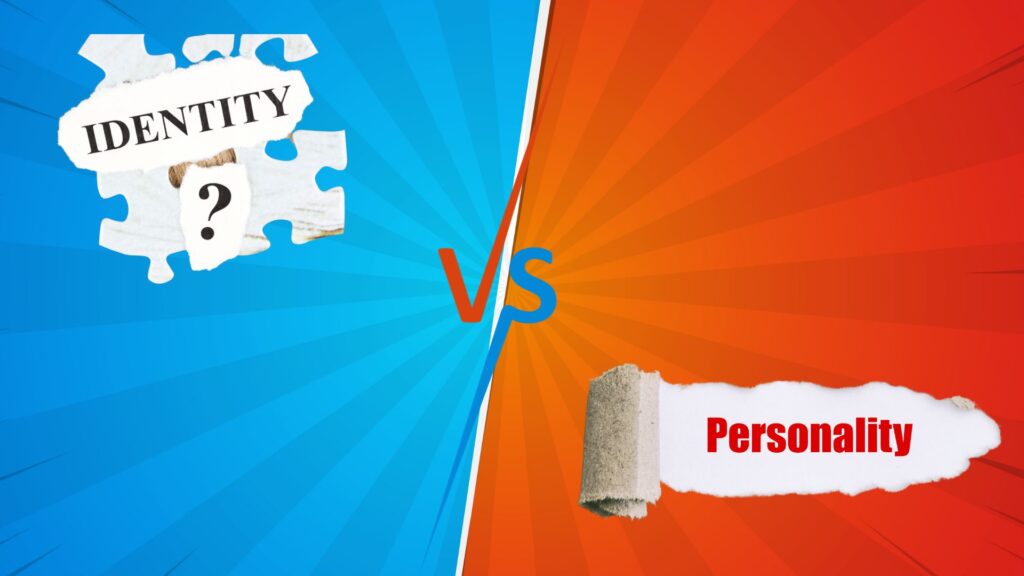What is Identity
Identity is a topic of interest to everyone in perpetuity, most relevant to children and adolescents. Identity and personality are often juxtaposed and sometimes used interchangeably.
Identity is what we identify as, with, and for
For instance, the values we identify with, the opinions that we hold, and the beliefs we live by all comprise identity.
Personality is the way we express our identity.
For instance, two people who identify with the same religion could express themselves within it in very different ways. Although identity and personality can be subject to change during adulthood or later life, the foundation usually develops during adolescence.

Up until the age of 13, children often mirror the preferences of their parents or older siblings. However, as they enter adolescence, they begin to form their own distinct likes and dislikes. Erik Erikson’s theory of identity development and the idea of an identity crisis are widely recognized and influential in this context.
According to Erik Erikson, a well-rounded identity is one that comprises values, beliefs, goals, and aspirations for life that a person is committed to. The awareness about this consistent commitment gets enhanced over time.
Identity Crisis
Several different determinants play a role in the development of identity mainly leaning on individual and social phenomena. According to Erik Erikson, most of this process and the development of a self-concept happens during adolescence. As adolescents undergo cognitive development, they start to identify with certain values and ideals influenced by the various role models they’ve encountered.
Erik Erikson referred to this period of development as an identity crisis when a significant amount of growth and differentiation in adolescents happens. Exploration is the main anchor in this process. During adolescence, teens explore different options to find things out based on their own experiences. They go through a psychological moratorium.
When a sense of identity is not achieved, it can result in identity confusion. When adolescents do not understand who they are or what their role in society is, identity confusion can occur.

Sometimes, exposure to cumulative racial discrimination or racial bullying can convolute identity confusion in teens.
Black adolescents experience at least 5 instances of racial discrimination within a single day. Anti-blackness which is often woven intricately into societal fabric can seem blurry and not easily recognizable. While the rates of reporting are the highest among Black youth, other racial/ethnic minorities also experience frequent race-based discrimination and bullying. Apart from identity, adolescence is also a very crucial period for emotional, physical, and behavioural development and strengthening. When teens fall prey to racial targets, significant problems in all these areas occur often slipping into adulthood as well.
The Impact of Racial Trauma on Minority Youth
Racial minority youth often are known to express extraordinary resilience drawn from cultural and familial strengths. However, when they are periodically exposed to racial discrimination, they can experience profound emotional and psychological injury. This is referred to as racial trauma. There are many different types of identity-based bullying such as gender-based bullying, ableism etc. Racial discrimination is one among them. Identity-based bullying can evoke several socioemotional responses threatening an individual’s sense of self, a feeling of safety, and a sense of belongingness to the community. This can thus also lead to interpersonal trauma resulting in heightened individuation. There is evidence mounting to show that the bully-victims experience higher levels of depression, anxiety, and suicidality. However, these complex mechanisms are poorly researched and not understood in their entirety.
Navigating Racial Identity and Imposter Syndrome
Sometimes, in an impetuosity to conform or in desperation to be accepted, adolescents may start adopting behaviors that are outside the spectrum of their racial practices. The more they adopt practices that are specific to another race, the less they are in touch with their own culture-specific practices. This can cause a great sense of confusion as they might sometimes resort to being a different person at home and a different one when out socializing. They can feel anxious in feeling that they are leaving behind people in their community in order to be a part of another. This can lead to adolescents experiencing racial imposter syndrome which causes a crisis regarding identity and mien. When individuals constantly feel like they don’t identify with their own race anymore because of revisions they’ve made to themselves, this can grossly affect their sense of well-being.
“Adolescents, in their eagerness to conform or be accepted, may sometimes adopt behaviors outside the scope of their racial practices. As they increasingly embrace practices specific to another race, they may become disconnected from their own cultural identity, leading to confusion and a dual persona—different at home and in social settings. This struggle can give rise to racial imposter syndrome, causing a crisis of identity and self-expression”

Identity crisis perpetuated by cumulative racial trauma is a real problem. Individual/s experiencing this must be spoken to with consideration, care, understanding, and a lack of judgment. Many of the weighted emotions come down in intensity when expressed verbally to a loved one or a therapist. Thus, talking about racial trauma could serve as an emotional release. Even though awareness of these topics is increasing, inevitably racial discrimination has a probability of occurring.
Fostering Resilience in Adolescents: The Vital Role of Parents in Addressing Racial Trauma
Parents play a crucial role in addressing racial trauma with adolescents.
By initiating conversations about these issues, parents ensure that teens understand the reality of racial trauma. Encouraging open dialogue empowers adolescents to express their experiences, and parents can provide valuable coping mechanisms. Preparing teens for such situations equips them to navigate them more effectively, reducing the novelty of these encounters and enhancing their emotional resilience. In cases of severe discrimination, such as by a teacher, parents should actively support their teens in reporting and addressing these incidents.
In conclusion, this article highlights the profound impact of racial trauma on an individual’s identity development, particularly during adolescence. It underscores the importance of recognizing and addressing these traumas to promote healthy identity formation. Addressing identity crises, compounded by cumulative racial trauma, requires sensitivity, understanding, and non-judgmental support. Encouraging open dialogue about racial trauma can provide emotional release, and parents should actively engage with their teens on these issues to equip them with coping mechanisms and the ability to confront and report instances of racial discrimination when necessary.
By fostering a supportive and empathetic environment, we can help individuals navigate identity crises and develop a strong sense of self, ultimately contributing to a more inclusive and compassionate society.
🤝 This is a special invite to ALL parents to join the conversation on World Mental Health Day, October 10th by 6 pm. We’re hosting a crucial round table discussion about the intersection of racial identity and young people’s mental health. 🧠💬
Parents, this is an opportunity to gain insights and share your experiences.
Let’s create a supportive space for our youth to thrive emotionally and culturally. Together, we can make a difference. 🌟

